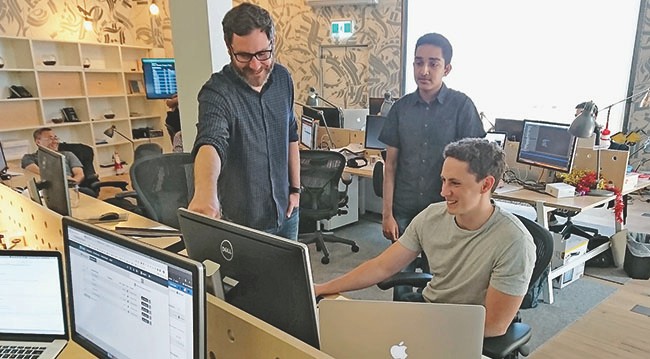Collaboration between industry, research and the community, Cooperative Research Centres (CRCs) boost innovation and growth but bring some governance challenges.
Professor Robert van Barneveld FAICD is passionate about the benefits of neurodiversity on boards. As chair of Autism CRC he works with a director who is on the autism spectrum and believes differences in brain function and behavioural traits enhance decision-making.
In 2016, the Autism CRC board appointed Malcolm Mayfield GAICD, founder and managing director of Autism STAR, a training, recruitment and advocacy firm for autistic people. Mayfield was diagnosed with Asperger Syndrome in his late thirties. Some directors were tentative about appointing an autistic director, says van Barneveld, managing director and CEO of the SunPork Group and a director of Pork CRC, who has led three successful CRC bids, including that for Autism CRC.
“We didn’t want a token appointment,” he says. “Every director on our board is chosen on merit and must contribute. That’s been the case with Malcolm. He’s had real impact.”
Van Barneveld says board clarity has improved. “People on the autism spectrum typically speak and hear very literally,” he notes. “Sarcasm and colloquialisms can be difficult for them to interpret. As a board, we must be precise in our language and consider how information is processed. It has led to more efficient board discussions.”
Autism CRC wants to encourage more people on the spectrum to develop governance skills. Through the new Sylvia Rodger Academy, Autism CRC launched the world’s first governance training program for autistic adults in November 2018. The aim is to develop future leaders, directors and researchers for the corporate and community sectors. The late Emeritus Professor Sylvia Rodger AM was Autism CRC’s founding CEO. The organisation is one of several CRCs innovating governance and driving a resurgence of interest in directorship in the sector. CRCs work at the vanguard of technology, disruption and cross-sector collaboration — board skills that are in high demand.
The federal government started the CRC Program in the early 1990s to support industry-led collaborations between academia, industry, government and the community. The government has so far committed more than $4b in funding to more than 200 CRCs, and their participants have committed another $12b in cash and in-kind contributions. There are 34 active CRCs across agriculture, mining, manufacturing and services. Although down from a peak of 72 in 2007, CRCs have become larger and other competing research programs have emerged. CRC companies aim to develop and commercialise innovations, spin off new ventures and link PhD candidates with industry.

Some CRCs have boards where directors represent key participants. Others have fully independent boards or a mix of independent and representative directors. The federal government requires CRC chairs to be independent and encourages board independence, with most CRC boards meeting between four and six times a year. Although it varies, non-executive director fees are around $25,000 and a chair might earn double that. Few CRC directors take the role solely for money.
CRCs on the move
Tony Peacock FAICD, CEO of the CRC Association, thinks the CRC sector has renewed momentum after a difficult period during the Rudd, Gillard and Abbott federal governments. “The current government understands the need to lift research and industry collaboration in Australia — and the role of CRCs in achieving this,” says Peacock.
Australia ranked last or second-last out of 26 OECD countries this decade on the proportion of small and medium-sized enterprises (SMEs) and large businesses collaborating with universities or other research institutions on innovation. It is a problem that CRCs address.
“It’s an interesting time for CRCs and their boards,” says Peacock. “Australia needs higher rates of innovation and commercialisation. It needs directors skilled at working across academia, industry and government — and governing organisations [which are] potentially developing disruptive technologies in emerging fields.”
CRC boards, he says, face several governance challenges. The first is a high proportion of representative boards, which limits the chair’s ability to “hire and fire” directors or choose those with certain skills. “The risk is the director governs on behalf of the CRC participant he or she works for, rather than for the CRC itself,” says Peacock. “Or the board has to deal with competing interests and may be affected by too many directors from a particular sector.”
He notes more CRC boards have moved to independent governance models or a mix of independent/representative directors this decade. Board sizes have also shrunk. CRC boards typically had more than 10 directors — one even had 19. Now the average size is between seven and 10 directors.
“There has been a professionalisation of governance in CRCs and, generally, a higher board standard,” says Peacock. “Under the old CRC model, ‘director tourism’ was a problem — directors showing up for a quarterly board meeting and being taken on a tour of a facility or listening to a presentation, and doing little else. CRC boards, these days, are very engaged in strategy, outcomes and general governance tasks.”
Legal structure has been a complication. Earlier CRCs often formed as joint ventures between participants, which complicated administration of intellectual property (IP). Peacock was an early advocate of CRCs forming as a company limited by guarantee, a common legal structure used by not-for-profit and charitable organisations. Diversity is another governance challenge. Women account for about 25 per cent of CRC directors, up from fewer than 20 per cent a decade ago, according to the CRC Association.
“Gender diversity on CRC boards has gone from awful to bad,” says Peacock. “We think 50 per cent is a reasonable target for women on CRC boards and the CRC Association is planning an initiative to lift gender diversity [at time of publication, to be launched at the CRC Association annual conference in May].”
Winding up a CRC is a complex board task, says Peacock. After the 2015 Miles Review of the CRC Program, funding was limited to 10 years to ensure CRCs “solved a problem rather than established an organisation”. The upshot is CRCs cannot ask the government for new funding when their term expires. To continue, they must secure funding from different sources, run the CRC in another structure or spin off technologies into new companies.
“Winding up is a hot governance topic in CRCs,” says Peacock. “Boards have to oversee the transfer of IP at the end of the CRC’s life, the spin-out and ownership of new companies if IP is commercialised, the management transition and the closure. Some CRC boards start preparing for the wind-up three years before the event.”
Benefits of CRC directorships
Katherine Woodthorpe AO FAICD is one of Australia’s leading CRC directors, having governed in the sector for 16 years. She chairs Antarctic Climate and Ecosystems (ACE) CRC, HEARing CRC, and was a director of Deep Exploration Technologies CRC, which successfully wound up in 2018. She is a former director of Capital Markets CRC and CRC Smartprint.
Woodthorpe says more directors from the commercial sector should consider CRC boards. “A CRC directorship can expand your governance skill set and give you a different and valuable board experience,” she says. “Directors wanting more exposure to technology, commercialisation and cross-sector collaboration will find that in the CRC sector.”
She believes the nature of CRC governance suits busy professional directors. “Because CRC boards tend to meet quarterly, the workload is less than for a corporate or large NFP board. CRC governance is challenging in its own way, but something you can combine with other roles.”
Woodthorpe was an early convert to the CRC program. “As a science nerd, I’m a great believer in the power of collaborative research,” she says. “The CRC program has delivered some of Australia’s most successful research outcomes, but there has been a lack of awareness in industry about the CRC sector and governance opportunities within it. That is changing as industry and the research community collaborate much more on innovation and commercialisation.”
Woodthorpe certainly wants to remain in CRC governance after ACE CRC and HEARing CRC close. For her, CRC governance is a passion. She recalls such highlights as visiting the Antarctic, viewing deep-exploration technologies at mine sites, seeing polymer banknotes printed, and the “immense privilege” of watching 14-month-old twins hear for the first time after receiving Cochlear implants. “You can get governance experiences in the CRC sector that are unlike any others,” she says.

Data to Decisions legacy
The Data to Decisions CRC brings together leading-edge research and development, innovation, and education and training to tackle big data challenges in Australia. The CRC formed in 2014 to tackle big-data problems facing Australia’s national security agencies. It received a $25m grant and attracted $67m in industry and university support. Now, its board is overseeing its closure at the end of this financial year. Chair Tim Scully says the board began planning for the CRC’s wind-up a few years into its funding agreement. “Five years of funding is a long time in a fast-moving field such as big data,” he says. “We deliberately sought a shorter time frame because we needed to get our technologies into the market and because big-data research is not subject to the long lead times that come with medical research CRCs. Our CRC has achieved a lot in that time.”
Scully says governing a CRC wind-up is challenging and management is a key consideration. Some staff might join its spin-off companies; others could seek new employment well before the CRC closes. “The board puts in place performance incentives, such as receiving equity in spin-off companies, for staff to remain with the CRC until it closes,” he says. “The directors have thought hard about how we ensure business continuity when we know the CRC is closing.”
Data to Decisions’ expected legacy is three commercialised technologies through two spun-out companies. The CRC’s flagship Apostle program aims to provide national security agencies with new tools to search and interrogate multimedia data from wide-ranging sources. The Integrated Law Enforcement program technology will provide police forces and analysts with uniform access to integrated data from different agencies.
Scully is proud of Data to Decisions’ work, saying, “Our team has done groundbreaking research in big data and national security. The goal was to develop world-first technology to help security agencies harness the power of big data and we are on track to do just that.”
Data to Decisions was an early adopter of board skill matrices, chose an independent directorship model and combined aspects of Department of Industry, Innovation and Science governance guidelines and ASX Corporate Governance Principles and Recommendations, and used various AICD governance tools.
Food Agility’s future
As some CRCs wind down, Food Agility CRC is growing. It formed in March 2017 after a $50m government grant over 10 years and another $160m committed by 54 partners across industry and academia. The CRC is one of Australia’s largest.
Chair Dr Anne Astin PSM MAICD wants the CRC to have an agile governance framework. “The board must be able to move quickly to support the CRC’s mission to lead a revolution in food production and supply while maintaining full accountability and transparency,” she says. “We’re looking at how the board can use real-time data and other technology in decision-making.”
Astin, a food scientist who also chairs Dairy Food Safety Victoria, says interest in CRC governance is growing. “Food Agility CRC had 61 applications for two advertised non-executive directorship positions. The quality of candidates was exceptional — some very experienced directors wanted to join our board.”
Food Agility CRC has three main governance challenges. The first is overseeing a strategic plan that can adapt as the organisation changes. “Ten years in this age of digital technology is a long time,” she notes. “We must consider how the CRC will change as it moves through its lifecycle towards commercialisation, and how the board and management will need to change to lead a fast-evolving organisation.”
The second challenge is developing agreements with 54 partners. “Different partners across different sectors have varied requirements around projects and implementation, intellectual property and potential conflicts of interest,” says Astin. “The board has done a lot of work on ensuring there are clear agreements with the CRC’s partners and absolute transparency.”
Reporting is the third challenge. “The federal government requires a different type of reporting to the university sector, and industry is different again,” says Astin. “It’s all manageable, but CRC boards must think carefully about the governance needs of diverse stakeholders. You are governing for industry, academia, government and the community.”
Astin nominates Food Agility’s oyster research — using real-time sensing and data modelling to measure salinity in growing fields and improve productivity, food safety and sustainability — as a highlight. “It’s another example of technology and cross-sector collaboration driving agrifood innovation.”
Latest news
Already a member?
Login to view this content


